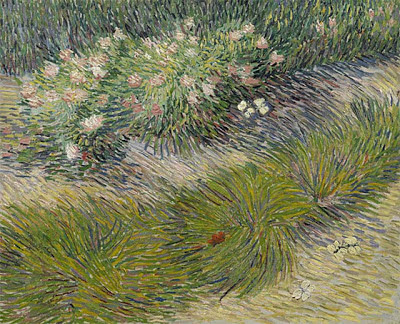I walked through, declining the headphones - partly out of respect for an artist who declined an entire ear, partly in gratitude for the DAM's exhibition materials which did not mention said ear at all . . .
"Don't say anything about the ear."
. . . but mainly because I did not want artistic judgment prejudiced or otherwise disposed by biographical material or other nonformal considerations, being a confirmed formalist in my limited appreciation of the visual arts. The museum's promotional materials featured the famous self portrait in the straw hat. I gather that Van Gogh, lacking funds to pay for models to sit, produced more than the usual artist's quota of self portraits, which may explain the "emotional intensity" noted in the exhibit placard near three such portraits, or what I suspect may also be a certain disgruntlement at having to sit there while painting his own portrait again.
Vincent's contemporary, Gauguin, of course, had the model problem all sorted out - just go to Tahiti where there's no currency, pick out some attractive naked women and, when you aren't painting them, sleep with them. No wonder Vincent, in his overcoats and hats and galoshes, looks . . . tense.
The exhibition doesn't include the iconic large works like the "Sunflowers" or "Starry Night," but in concentrating on his artistic development and his peripatetic life it presents him as a human being with periods of normalcy - a small painting he gave his sister . . .
. . . his studiousness in combining Japanese landscape painting with French impressionism . . .
"Grass and Butterflies"
But who's to say, maybe it helped. The "divine afflatus" doesn't visit often. Most of us just stay at home and cut the grass to keep out the butterflies.






No comments:
Post a Comment